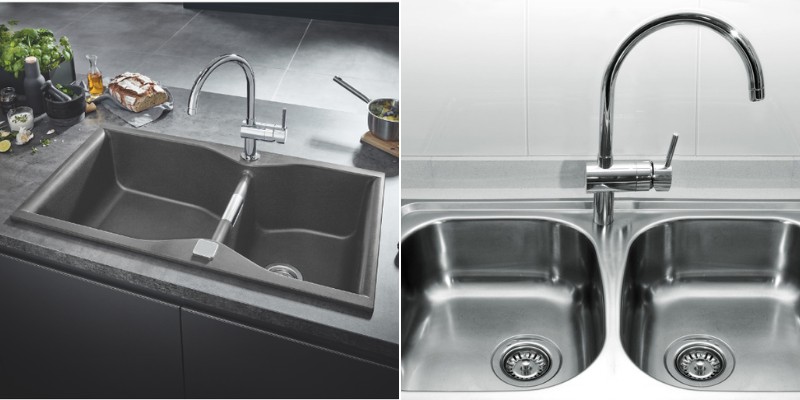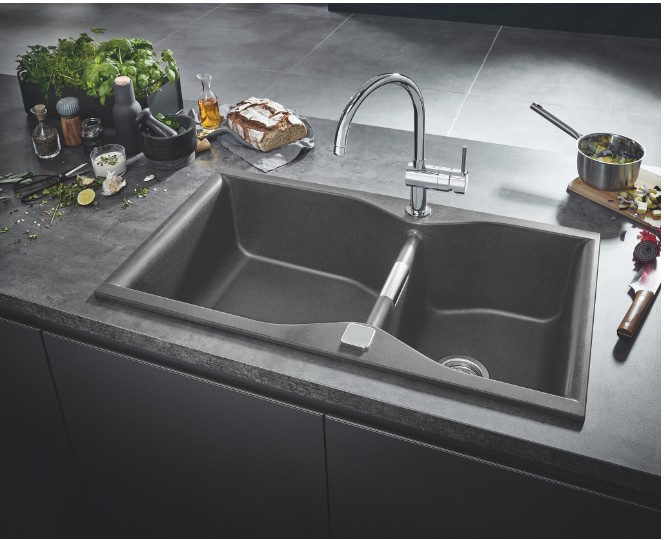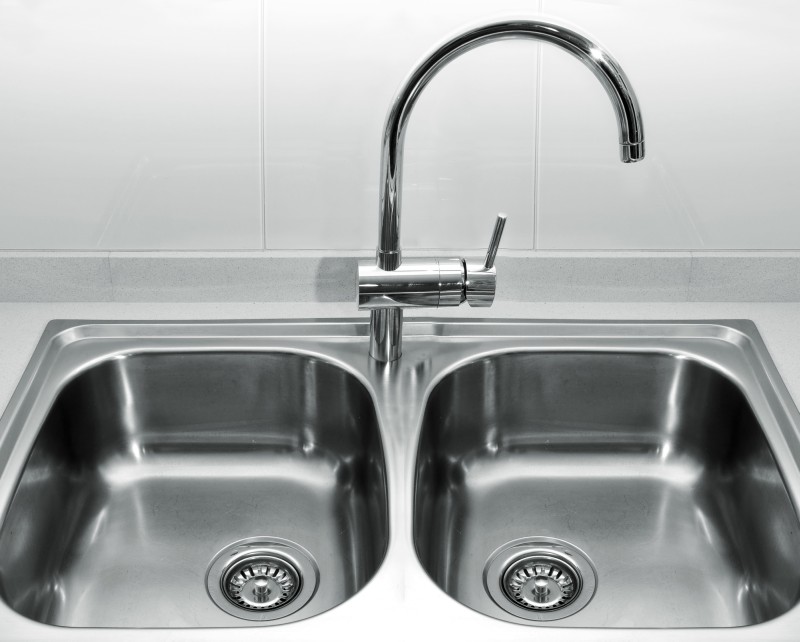You’ve whittled down your kitchen sink choices to granite composite and stainless steel. Now, you’re debating which kind to choose.

You like the looks of both colored stone and gleaming steel. Yet, you wonder which type of fixture will serve you best.
I’d like to help you decide. In this post, I compare the pros and cons of granite composite and stainless steel sinks regarding:
– construction
– durability
– scratch and stain resistance
– maintenance and cleaning
– longevity
– design choices
– average cost
I also answer common questions, such as “How long does a granite composite sink last?” and “What finishes are available for stainless steel sinks?” After reading this post, you’ll be well-informed to make a great choice!
Granite Composite Sinks

Construction
A granite composite sink is made of acrylic resins and quartz sand or granite stone dust. The amount of each material varies by sink brand. Still, most high-quality sinks are roughly 80 percent quartz sand and 20 percent resins.
Surface Appearance
Unlike a granite countertop, a granite composite sink lacks the veining of stone. Instead, it may show a fine speckling from stone dust. Or the surface may have no grain.
Either way, granite composite sinks have a matte finish, treated with a protective coating.
Design Versatility
With a granite composite sink, you’ll have plenty of color choices! Among them are black, beige, white, gray, light peach, and various shades of brown. Moreover, the bowls come in several styles and sizes.
Weight
Granite composite sinks are heavy and cumbersome, weighing over 40 lbs. To install one, you need a strong base cabinet and countertop. Otherwise, the countertop may buckle, sending the sink into the base cabinet.
Thus, installation can be more challenging than with a stainless steel sink. If you doubt the sturdiness of your existing framework, give it more structural support. Or consider hiring a contractor.
Stainless Steel Sinks

Composition
A stainless steel sink consists of a steel “alloy,” a mixture of chromium, nickel, and steel. The composition is expressed in fracture form, such as 18/8 steel.
Grade
In industry terms, this ratio is the stainless steel “grade.” It’s the percentage of chromium and nickel in the steel alloy.
With 18/8 steel, the alloy is 18 percent chromium and 8 percent nickel. High grades indicate better steel properties, such as stain resistance.
Gauge
Another mark of quality is the steel “gauge” or thickness. Generally, stainless steel sinks are 16 to 22 gauge. Higher gauges reflect thinner, weaker steel.
So, when shopping for a stainless steel sink, look for a low gauge. Most homeowners go with 18-gauge steel. Or if you want a super-strong sink, choose 16-gauge.
Surface Appearance
The most popular finishes for stainless steel sinks are satin and brushed. A satin finish has a soft luster, kind to your eyes. On the other hand, a brushed finish excels in hiding scratches.
Endurance
The lifespan of a stainless steel sink ranges from 20 to 30 years, depending on usage. Meanwhile, it won’t tarnish or rust. Moreover, it can take the impact of kitchenware without chipping or cracking.
Noisy with Use
When water and kitchenware touch a stainless steel sink, it vibrates slightly, creating noise. With side-by-side basins, the sounds are amplified. Still, you can lessen the sound effects in several ways, which I explain later in this post.
Granite Composite Vs. Stainless Steel Sinks
1. Durability
Stainless steel sinks are tops in durability! While granite composite sinks are strong, they can chip and crack, especially when subject to high heat. Plus, since the bowls are rigid, fragile kitchenware can shatter if dropped.
Conversely, stainless steel sinks are more resilient. If you drop kitchenware in a stainless steel basin, it gives slightly, absorbing the impact. In turn, fragile vessels are less likely to break.
Meanwhile, the chromium in the steel alloy defies corrosion.
2. Scratch Resistance
Granite composite sinks are impervious to scuff marks from kitchenware. Thus, they’re superior to stainless steel sinks in scratch resistance.
Scrapes are less visible on certain stainless steel finishes, such as matte and brushed. While a mirror finish gleams when new, it also highlights blemishes.
To help prevent scratches, use non-abrasive cleaning products. Also, consider placing a metal grid on the bottom of the basin. Avoid using a rubber mat since it will collect food particles and chemicals while attracting mold.
3. Stain Resistance
Stainless steel basins are less prone to permanent splotches than granite composite sinks. However, it’s important to rinse and wipe down a stainless steel sink after each use. Otherwise, you may see residual water spots.
Lightly-colored granite composite sinks are most vulnerable to stains. Those from acidic foods are especially stubborn. So, after washing dishes, be sure to rinse your basin thoroughly.
4. Maintenance
A stainless steel sink is low-maintenance. All it needs is a thorough cleaning once weekly.
On a granite composite sink, the protective coating can degrade. In particular, hot kitchenware can melt the resins. As the coating deteriorates, the sink surface gets dull or hazy.
At that point, you’ll want to restore the coating. Or you can be proactive with annual maintenance.
5. Ease of Cleaning
Stainless steel sinks win this category! That’s because stains can be tough to remove on granite composite sinks.
While strong chemicals can banish stains, they can also mar granite composite material. Avoid using acidic cleaning agents, such as vinegar. Instead, check the manufacturer’s instructions for a safe, pH-neutral cleaning product.
Then, for general cleaning, use mild dish detergent, warm water, and a sponge. Once you soap up the sink, rinse and dry it well.
6. Cost
Generally, granite composite sinks are more expensive than stainless steel. However, prices vary by sink brand, size, and design. With stainless steel fixtures, additional cost factors are the steel gauge and finish.
Below are average prices for granite composite sinks:
- top-mount – $150 to $400
- under-mount – $250 to $800
Here are median costs for stainless steel sinks:
- top-mount – $100 to $300
- under-mount – $200 to $450
Note that these figures don’t include installation, which tends to cost more with granite composite sinks.
7. Availability
Stainless steel sinks are widely sold. You can buy them at:
- Costco
- Lowe’s
- Home Depot
- kitchen supply stores
- hardware stores
- online
Large department stores sell granite composite sinks, but they have limited stock. So, before heading out to shop, research online first. Then, call your local hardware, asking if the store carries your desired model.
8. Aesthetics
Both granite composite and stainless steel sinks are classy! With granite composite, you can match the color to your walls or kitchen decor.
Do you have stainless steel kitchen appliances? If so, a sink of the same material will create a unified look.
9. Resource Sustainability
Stainless steel is recyclable, reducing wastefulness and landfill clutter. During recycling, stainless steel retains its stability and strength. Thus, a stainless steel sink is an Earth-friendly choice.
FAQ About Granite Composite Sinks
Why does my granite composite sink have white stains?
White stains on a granite composite sink can be from hard water mineral deposits and soap scum. Or the stains can reflect damage by chemicals or heat.
Hard Water Stains on a Granite Composite Sink
Hard water has high concentrations of minerals, such as magnesium, calcium, and possibly lime.
If you don’t dry a granite composite sink after each use, the residual water will evaporate. As it does, the minerals in hard water bond to the bowl, forming spots.
You can remove hard water stains with specially-formulated products, such as CLR and Lime-Away. To help prevent future white stains, dry your sink after each use.
Soap Scum Buildup on a Granite Composite Sink
Additionally, when hard water minerals and soap combine, they form a sticky residue. To eliminate soap scum, use a cleaner made for granite composite sinks.
Chemical and Heat Damage to a Granite Composite Sink
White stains can also result from harsh cleaning products, such as those with ammonia or bleach. Other damaging agents are paint thinners and drain cleaners.
Unfortunately, blemishes caused by chemicals are permanent. Also non-removable are white spots rendered by hot pots and pans.
How long does a granite composite sink last?
If you reseal a granite composite sink annually, it can serve you well for 25 years or more.
How do you restore the coating on a granite composite sink?
Replacing the coating on a granite composite sink is easy! Here’s the step-by-step process.
- Apply a cleaner and sealant to a sponge or soft cloth, gently rubbing the sink surfaces with it.
- Rinse the sink to remove the product residues. Then, dry the surfaces with a towel.
- Prepare the sink for polishing by cleaning it with a mild detergent and water. After rinsing the sink, dry it with a lint-free towel.
- Apply a quarter-sized amount of a polishing agent to a soft cloth. Using circular motions, rub the polish on the sink, covering it completely.
- Let the polishing material dry to a faint haze.
- Buff the sink with a dry cloth, using circular motions to remove all the haze.
FAQ About Stainless Steel Sinks
What finishes are available for stainless steel sinks?
Choose from five attractive finishes for a stainless steel sink:
- brushed
- matte
- satin
- polished or mirror
- textured or decor
Each finish reflects light uniquely and has a particular grain pattern, described below.
Brushed – displays a soft glow and a hairline grain with excellent scratch resistance.
Matte – dull appearance and thicker straight grain, camouflaging scrapes.
Satin – exhibits a wide straight grain and a mild sheen. While a satin finish has a lovely radiance, it emphasizes scuff marks.
Polished or Mirror – emits a dazzling shine with a subtle wavy grain. A mirror finish showcases water spots and scratches.
Textured or Decor – embellished with a raised design and intricate grain, superior for hiding scuff marks. Still, a textured finish attracts oily kitchen smoke, creating a dull film over time, tough to remove.
How can I reduce the noise of a stainless steel sink?
The features below can minimize the sound effects of a stainless steel sink:
- 16 or 18-gauge steel, absorbing noise better than a higher gauge
- sound-deadening pads on the underside of the sink
- sound-dampening coatings
If your desired model doesn’t come with insulation, you can apply it. The most user-friendly type is mass-loaded vinyl, such as the 3M Automotive Sound Reduction Mat. This material curbs road noise and vibration when driving a vehicle. Remarkably, it lowers sink noise, too!
This post explains how to soundproof a stainless steel sink.
How do you clean a stainless steel sink?
Apply a cleanser with a sponge or soft cloth, rubbing in the direction of the sink’s grain. Avoid using abrasive sponge pads, a wire brush, or steel wool since they’ll leave scratches.
For cleansers, one option is a commercial product designed for stainless steel. Or you can use mild dish soap. For a safe homemade cleaner, combine baking soda and vinegar.
Then, after each use, wipe the sink with a damp sponge and buff it dry. This practice deters water spots.
How to disinfect a stainless steel sink?
Use diluted bleach to disinfect a stainless steel sink, explained below. Be sure to wear rubber gloves during this process to protect your skin.
- Fill your sink one-quarter deep with a 50/50 mixture of bleach and water. Let the solution sit for 15 minutes.
- Start draining the bowl while sponging it down with the solution.
- Rinse the basin and counter thoroughly.
- Buff the sink dry with a soft cloth.
Enjoy the gleam of your stainless steel sink!
Sink Savvy
Let’s summarize the pros and cons of granite composite and stainless steel sinks.
Granite Composite Sink Upsides
- Superior scratch resistance compared to stainless steel.
- Comes in several colors, sizes, and styles.
- With annual sealing, has a lifespan of at least 25 years.
Granite Composite Sink Downsides
- Stains can be hard to remove, especially if neglected.
- Due to the sink’s rigidity, fragile kitchenware can shatter if dropped.
- The basin can chip and crack with impact, especially if subject to high heat.
- Heavy, requiring sturdy countertop and base cabinet support.
- Needs annual sealing to maintain its protective coating.
- Physical stores have limited stock; best to shop online.
Stainless Steel Sink Upsides
- Resists corrosion, tarnishing, and stains.
- Absorbs the impact of kitchenware, making damage less likely.
- Easier to install than a granite composite sink.
- Simple to maintain and clean.
- Long lifespan, ranging from 20 to 30 years.
- Comes in radiant finishes, complementing stainless steel appliances.
- More widely sold and less costly than a granite composite sink.
Stainless Steel Sink Downsides
- Prone to scratching.
- Vibrates with use, rendering noise.
Now, you’re an expert on granite composite and stainless steel sinks. Have fun shopping!
Related Posts
- 11 Ways to Get Rid of Cooking Smells in a Small Apartment or House
- Comparison of Corian Countertops vs Laminate for Kitchens
- All About Fragranite Kitchen Sinks With Pros & Cons
- How Much Does it Cost to Paint Kitchen Cabinets?
- What Color Granite Goes With Maple Wood Kitchen Cabinets?
- What Color Granite Goes With White Cabinets – Some Design Ideas
Leave a Reply